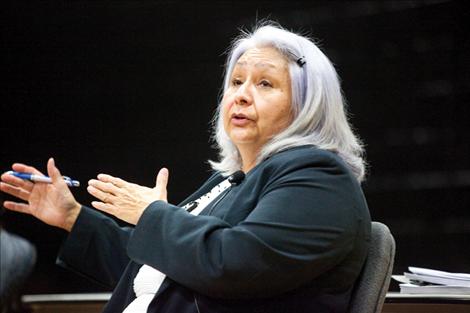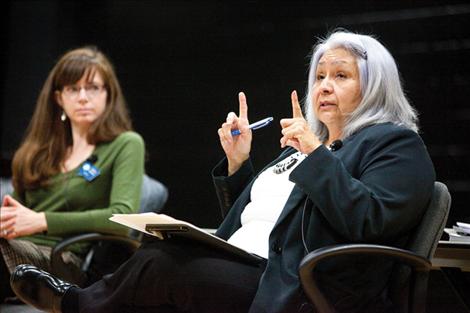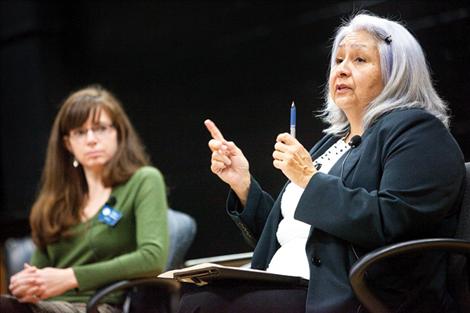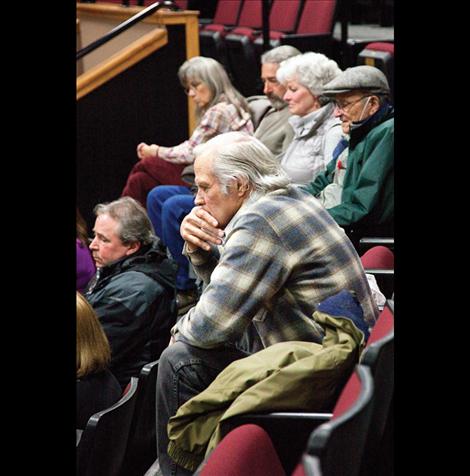Bipartisan group hears water compact details
Hey savvy news reader! Thanks for choosing local.
You are now reading
1 of 3 free articles.
PABLO – The Confederated Salish and Kootenai Water Compact pending before the legislature has a long history of legal precedent that played into negotiating a settlement between tribal, state, and federal government, tribal and state attorneys told a bipartisan group of listeners last week.
In a joint meeting of the Lake County Democrats and Lake County Republican Women, tribal attorney Rhonda Swaney and Montana Reserved Water Rights Compact Commission Attorney Melissa Hornbein explained the complexity of the document, its legal history and possible outcomes if the bill is or isn’t passed.
Swaney explained that the settlement would finalize tribal water claims in western Montana through a negotiated agreement that limits claims to west of the continental divide and will keep the tribes from having to file as many as 10,000 claims as far east as Billings in the group’s aboriginal homeland. A June 30, 2015 deadline is set in place for the tribes to file their claims, meaning time is short for the legislature to pass the document. If the legislature passes the agreement it must then be ratified by the United States Congress and the Confederated Salish and Kootenai Tribes. The Tribes have not decided whether or not the issue will be put to a vote by Tribal Council or a popular vote of tribal members, Swaney said.
While it may seem strange that the tribes can file for off-reservation claims, a long legal history supports the tribal water claim Swaney said.
“Montana is in the western United States,” Swaney said. “It has a history of mining and agriculture and those uses primarily triggered the water laws that we have which are first in time, first in right. Those people who are putting water to beneficial use first have rights. Those coming along later and putting that water to beneficial use have junior rights. What kind of messed that orderly system process up is federal reserved rights.”
Federal reserved water rights resulted from a 1908 ruling by the United States Supreme Court that said Indian tribes have a federally reserved water right created with the reservation. The federal government later passed the McCarran amendment, which waived the United States’ sovereign immunity and gave authority to negotiate settlements of the rights with state and tribal government. Sixteen water compacts, including five for Indian reservations, have been passed in the state of Montana, including one for the National Bison Range. The Confederated Salish and Kootenai Water Compact is the last pending agreement.
Another 1905 ruling determined treaties that declare tribes have the right “to fishing at usual and accustomed places” means tribal members can go off-reservation to fish.
“The Supreme Court interpreted that to mean that you get to fish off the reservation, and it can even be on fee patented land,” Swaney said. “This is the source of off-reservation rights in the compact, and people are really confused because that just doesn’t seem right, but if you can reverse your mindset and think like an Indian, you were occupying a territory. You were used to hunting and fishing. You were occupying a territory and moved around. That was your usual and accustomed way of life.”
Swaney said the rights to that way of life were reserved by Native Americans in the treaties.
“While it may not seem right to us today, there is a whole 100, 200 years of case law that says you have to recognize treaties,” Swaney said. “You have to interpret them as how Indians would have understood them when they were negotiated, and you have to give them credit for the fact that they didn’t speak the English language and if there is a doubt you have to decide in favor of the Indian tribes. That kind of butts heads with the ‘first in time, first in right’ way of life.”
But negotiated agreements have been reached on all of Montana’s other reservations, and Swaney said it is preferable that that be done on the Flathead Reservation also. After a failed initial attempt at passing a previous version of the compact in 2013, negotiations were reopened in 2014 to get a deal that gives much more protections to irrigators using the Flathead Indian Irrigation Project, Swaney and Hornbein said.
Among the new pieces of irrigation protection are provisions that deliver historically verified amounts of water to river diversions, instead of implementing a previously suggested individual on-farm water allowance that used unverified averages calculated by satellite photos and computer modeling systems. In the new compact the water is delivered to the gates of the project, and the project operator has the authority and responsibility to distribute it.
The compact will also provide a written certificate that clarifies that irrigators have a right to water delivery and that right to delivery runs with the land.
Irrigators who want to have their day in Montana Water Court will also be able to do so, Hornbein said. In the previous version the compact, there wasn’t that possibility.
That said, Swaney acknowledged that the agreement is controversial. She said she faces criticism daily that the tribes gave too much away.
One person critical of the settlement is tribal member Nikos Pastos, who told Swaney he would like negotiations to continue so the tribes can get more from the deal.
Others think it is fair.
“If all parties agree that they don’t like it, if all parties agree that they aren’t getting exactly what we want, then it must be pretty darn fair,” audience member Susan Evans said.



































